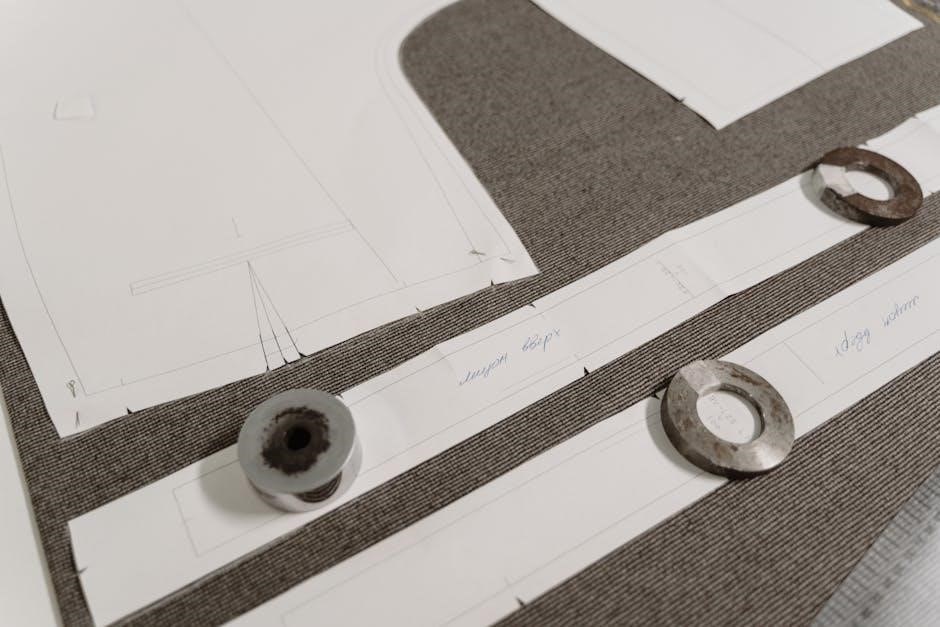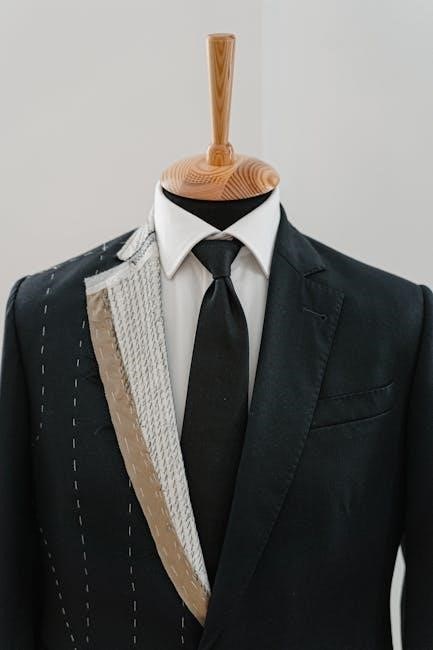This guide provides essential tips for accurately measuring t-shirts‚ ensuring the perfect fit. Learn how to measure key areas like chest‚ shoulders‚ and sleeves effectively. Discover the tools and techniques needed to determine your size and find your ideal t-shirt fit with confidence.
1.1 Importance of Accurate Measurements
Accurate measurements are crucial for ensuring a comfortable and flattering fit. Proper sizing prevents issues like tightness or looseness‚ enhancing both comfort and appearance. It also minimizes the need for exchanges or alterations‚ saving time and effort. Additionally‚ precise measurements account for fabric stretch and shrinkage‚ ensuring long-term wearability. By understanding key measurements‚ you can confidently select the right size‚ aligning with personal style preferences for a polished look.
1.2 Purpose of the Guide
This guide aims to simplify the process of measuring and selecting the perfect t-shirt. By providing clear‚ step-by-step instructions‚ it helps individuals determine their ideal size and fit. The guide covers essential measurements‚ tools needed‚ and how to interpret size charts. It also addresses common mistakes and offers tips for ensuring accuracy. Whether shopping online or custom-making‚ this resource empowers users to make informed decisions‚ ensuring a comfortable and stylish fit every time. It’s designed for both beginners and experienced shoppers seeking precision and confidence in their choices.

Tools Needed for Measuring
A soft‚ flexible measuring tape is essential for accurate body measurements. Use a flat surface to lay the t-shirt for consistent garment measurements. A sizing chart or ruler helps ensure precision and alignment with standard size guidelines.
2.1 Soft‚ Flexible Measuring Tape
A soft‚ flexible measuring tape is crucial for accurate t-shirt measurements. It allows you to measure body circumference‚ such as chest and waist‚ without compressing fabric. The tape should be smooth and pliable to ensure a snug‚ even fit. Use it to measure key areas like sleeve length and shoulder width. This tool is essential for both body measurements and garment-specific sizing‚ helping you achieve precise fits and avoid sizing errors. Always ensure the tape is flat and not twisted for consistent results.
2.2 Flat Surface for Measurements
A flat surface is essential for accurate t-shirt measurements. Lay the garment on a smooth‚ even surface‚ ensuring it is wrinkle-free and fully spread out. This allows for precise measurements of key areas like body width‚ length‚ and sleeve openings. Avoid measuring on uneven or soft surfaces‚ as this can distort the fabric and lead to inaccurate sizing. Use a table or countertop to ensure the t-shirt lies flat‚ making it easier to measure evenly and consistently. A flat surface guarantees reliable results for both body and garment measurements.
2.3 Sizing Chart or Ruler
A sizing chart or ruler is a crucial tool for ensuring accurate measurements when working with t-shirts. It helps align designs and patterns precisely‚ guaranteeing consistency across different sizes. A sizing chart provides standardized measurements for various sizes‚ making it easier to compare and match your measurements. A ruler‚ especially one designed for t-shirt sizing‚ can be used to measure specific details like sleeve length‚ body width‚ and hem circumference. Together‚ these tools ensure that your measurements are precise and scalable‚ whether you’re creating custom designs or selecting the right size for production.
Key Measurements for T-Shirts
Accurate measurements are vital for a perfect fit. Key areas include chest circumference‚ shoulder width‚ body length‚ sleeve length‚ and hem circumference. Measure these carefully for consistency.
3.1 Chest Circumference
Chest circumference is a critical measurement for determining t-shirt size. It is measured around the fullest part of the chest‚ typically just under the armpits. Use a soft‚ flexible tape measure and ensure it is level and not too tight or loose. Stand up straight with arms slightly raised for an accurate reading. This measurement helps determine the width of the t-shirt and ensures a comfortable fit. For garments‚ measure the chest width from one side seam to the other‚ ensuring the t-shirt lies flat on a surface. This ensures consistency and accuracy in sizing.
3.2 Shoulder Width
Shoulder width is measured across the top of the shoulders‚ from one shoulder tip to the other. For body measurements‚ place the tape measure horizontally across the back‚ ensuring it is level and not tilted. For garment measurements‚ measure the distance between the two shoulder seams. This measurement helps determine how the t-shirt will fit across the upper body. Accurate shoulder width ensures the garment sits comfortably‚ neither too tight nor too loose. Proper alignment is key for a flattering fit‚ so maintain a straight posture during measurement.
3.3 Body Length
Body length is measured from the collar seam at the base of the neck down to the bottom hem of the t-shirt. This measurement ensures the garment is the desired length‚ whether it’s cropped‚ standard‚ or long; For accurate results‚ lay the t-shirt flat on a surface‚ smoothing out any wrinkles. Measure in a straight line from the collar’s center back to the hem’s center. This length determines how the t-shirt will fit on the torso‚ so precision is crucial for the right style and comfort level.
3.4 Body Width
Body width is measured from one side seam to the other‚ typically just below the armholes. This measurement helps determine how loose or fitted the t-shirt will be across the chest. To ensure accuracy‚ lay the t-shirt flat and smooth out any wrinkles. Measure straight across the garment at the widest point‚ usually 1-2 inches below the armhole. This measurement‚ combined with chest circumference‚ helps in selecting the correct size for a comfortable and flattering fit. Always use a flexible tape measure for precise results.
3.5 Sleeve Length
Sleeve length is measured from the shoulder seam to the cuff’s edge. For accuracy‚ lay the t-shirt flat and smooth the fabric. Align the tape measure with the outer edge of the sleeve‚ ensuring it follows the natural curve. Short sleeves typically range from 6 to 11 inches‚ while long sleeves extend to the wrist. Proper measurement ensures the sleeves fit comfortably without being too short or overly long. This step is crucial for achieving a balanced and flattering fit‚ especially for styles like crew necks or V-necks.
3.6 Sleeve Opening
Sleeve opening refers to the circumference of the sleeve at the cuff. Measure around the widest part of the sleeve’s hem while the t-shirt is laid flat. Ensure the fabric is smooth and not stretched. This measurement is vital for comfort‚ especially for fitted or athletic styles. Proper sleeve opening ensures ease of movement and a flattering silhouette. Accurate measurement helps in selecting the right size‚ avoiding sleeves that are too tight or overly loose‚ thus enhancing overall comfort and aesthetic appeal.
3.7 Neck Opening
Neck opening measures the circumference of the neckline. Place the tape around the middle of the neck‚ ensuring it’s level and not too tight or loose. This measurement is crucial for comfort and style‚ as it determines how the t-shirt sits on the body. A well-fitted neckline enhances both aesthetics and functionality‚ preventing the shirt from being too restrictive or overly sloppy. Accurate neck measurements ensure a comfortable fit‚ making it easier to choose the right size for various styles‚ from crew necks to V-necks‚ and maintain a polished appearance.
3.8 Hem Circumference
Measure the hem circumference by laying the t-shirt flat and measuring across the bottom from one side seam to the other. Keep the tape measure straight and level‚ avoiding stretching the fabric. This measurement helps determine the shirt’s fit and balance. A larger circumference may result in a looser fit‚ while a smaller one could appear tighter. For accuracy‚ measure without stretching‚ even if the fabric is stretchy. Compare your measurement to size charts to ensure the right fit and appearance‚ whether the hem is curved‚ ribbed‚ or standard.
3.9 Waist Measurement
For women’s t-shirts‚ the waist measurement is taken at the narrowest point of the torso‚ typically just above the hipbone. Place the measuring tape horizontally around the natural waistline‚ ensuring it’s snug but not too tight. This measurement helps determine the fit at the midsection‚ especially for styles that are fitted or tapered. For men‚ this measurement may align with the chest or be slightly smaller‚ depending on the shirt’s design. Always measure while the t-shirt is flat to get an accurate reading and compare it to the size chart for the best fit.
How to Use the T-Shirt Size Chart
Align your body measurements with the size chart to find your perfect fit. Compare chest‚ waist‚ and sleeve measurements to determine your ideal size accurately and effortlessly.
4.1 Matching Measurements to Sizes
Matching your measurements to sizes is crucial for a perfect fit. Start by measuring your chest circumference at the fullest part‚ ensuring the tape is level and not too tight. Compare this measurement to the size chart‚ noting the corresponding size. Next‚ measure your waist‚ typically just above the navel‚ and align it with the chart. Sleeve length is measured from the shoulder to the wrist. By cross-referencing these measurements‚ you can determine your ideal size‚ whether it’s S‚ M‚ L‚ or XL. This method ensures accuracy and comfort‚ helping you avoid sizing discrepancies.
4.2 Understanding Size Labels (S‚ M‚ L‚ XL)
Understanding size labels is key to selecting the right fit. Sizes like Small (S)‚ Medium (M)‚ Large (L)‚ and Extra Large (XL) correspond to specific measurement ranges. Typically‚ these labels are based on chest circumference‚ with S fitting around 34-36 inches‚ M around 38-40 inches‚ L around 42-44 inches‚ and XL around 46-48 inches. These standards help align your body measurements with the appropriate size‚ ensuring comfort and accuracy. However‚ sizes may vary slightly between brands‚ so always refer to the specific size chart provided for the best fit.
4.3 Considering Fit Preferences
Fit preferences play a crucial role in choosing the right t-shirt size. Some individuals prefer a slim fit for a modern look‚ while others opt for a loose fit for comfort. Measurements should align with personal style‚ ensuring the t-shirt isn’t too tight or overly baggy. If you prefer a relaxed fit‚ consider sizing up‚ while a tailored look may require staying true to your measurements. Understanding your fit preference ensures the t-shirt complements your body type and meets your comfort expectations‚ making the sizing process more personalized and effective.
Fitting Guide for T-Shirts
A proper fit enhances comfort and appearance; Consider fabric type‚ as stretchiness affects how the t-shirt drapes. Account for shrinkage and choose styles that suit your body shape.
5.1 How Fabric Type Affects Fit
Fabric type significantly impacts how a t-shirt fits and feels. Cotton is breathable and soft‚ ideal for casual wear‚ while polyester offers durability and moisture-wicking properties. Blends like poly-cotton combine comfort and longevity. Fabric weight also matters—lighter fabrics drape more‚ while heavier ones provide structure. Stretch fabrics‚ such as those with elastane‚ offer flexibility and a snug fit. Understanding fabric types helps you choose a t-shirt that aligns with your comfort and lifestyle preferences‚ ensuring a flattering and comfortable fit.
5.2 Understanding Shrinkage Factors
Shrinkage is a common factor in t-shirts‚ particularly with natural fibers like cotton. Most cotton t-shirts shrink up to 5% after the first wash. Pre-shrunk fabrics minimize this effect‚ but it’s essential to consider when choosing a size. Washing in hot water or drying at high heat can increase shrinkage. To maintain fit‚ opt for cold washes and air drying. Always check labels for pre-shrunk information to ensure your t-shirt retains its shape and size‚ avoiding unexpected resizing after care.
5.3 Choosing the Right Style
Choosing the right t-shirt style involves considering fabric type‚ fit preferences‚ and personal comfort. Fabric weight and texture play a significant role in how the t-shirt drapes and feels. Slim-fit styles hug the body‚ while relaxed fits offer more comfort. Consider your physique and lifestyle when selecting a style. For casual wear‚ a standard fit is ideal‚ while athletic builds may prefer slim-fit designs. Measure your body and compare with size charts to ensure the best fit. Additionally‚ think about the occasion and how the t-shirt will be worn to make an informed choice.

Common Mistakes to Avoid
Avoid common mistakes like measuring without assistance‚ ignoring fabric stretch‚ and not accounting for shrinkage. These errors can lead to poor fit and discomfort. Ensure accuracy for the best results.
6.1 Measuring Without a Helper
Measuring without assistance often leads to inaccuracies‚ as it’s challenging to ensure the tape is level and correctly positioned. This is especially true for chest and shoulder measurements. Without a helper‚ the tape may not be snug or properly aligned‚ resulting in incorrect sizing. Using a mirror can help‚ but it’s not a reliable substitute for another person. For precise measurements‚ enlist a helper to ensure accuracy and avoid fit issues. Proper alignment and tension are crucial for reliable results‚ especially when measuring curved areas like the chest and shoulders.
6.2 Ignoring Fabric Stretch
Neglecting fabric stretch is a common mistake that can lead to poor fit. Different materials have varying degrees of stretch‚ and failing to account for this can result in a shirt that is either too tight or too loose. For instance‚ cotton blends may shrink or lose elasticity over time‚ while synthetic fibers like polyester retain shape better. Always consider the fabric type when measuring and choosing sizes to ensure a comfortable and lasting fit. This step is crucial for achieving both style and comfort in your t-shirt choice.
6.3 Not Accounting for Shrinkage
Shrinkage is a critical factor often overlooked when measuring t-shirts. Natural fibers like cotton may shrink after washing‚ affecting the fit. Always pre-shrink garments before measuring to ensure accuracy. Consider the fabric type‚ as synthetic blends tend to shrink less than pure cotton. Measure t-shirts after washing and drying to account for any size changes. Ignoring shrinkage can result in a garment that no longer fits properly‚ making it essential to factor this in for a precise and lasting fit. Properly accounting for shrinkage ensures your measurements remain reliable over time.

Youth T-Shirt Measurement Guide
This guide focuses on size charts for kids and teens‚ ensuring proper fit. Measure chest‚ shoulders‚ and length to determine the ideal youth t-shirt size accurately.
7.1 Age-Appropriate Measurements
Measuring kids and teens requires attention to their growth stages. For youth t-shirts‚ measure chest circumference at the fullest part‚ ensuring the tape is flat and parallel to the floor. Shoulder width is taken from one shoulder tip to the other. Body length is measured from the collar seam to the bottom hem. Sleeve length is determined by the distance from the shoulder to the wrist. Ensure the fit allows for comfort and growth‚ avoiding tight or overly loose garments. Align these measurements with size charts to find the perfect fit for children and teenagers.
7.2 Size Chart for Kids and Teens
Size charts for kids and teens are designed to accommodate growing bodies‚ with measurements based on age and body proportions. Typical sizes range from XS to XL for youth. Chest circumference is a key measurement‚ with sizes increasing by about 2-3 inches per size. For example‚ a youth small might be 28-30 inches‚ while a youth XL could be 36-38 inches. Body length and sleeve length also vary‚ ensuring a comfortable fit. Always compare measurements to the chart to ensure the best fit for children and teenagers.

Women’s T-Shirt Measurement Guide
Women’s t-shirt measurements focus on bust‚ waist‚ and hip proportions. Use a flexible tape measure around the fullest part of the bust for accurate sizing‚ ensuring comfort and style;
8.1 Female-Specific Measurements
Female-specific measurements for t-shirts focus on the bust‚ waist‚ and hip proportions. To ensure accuracy‚ measure the bust by wrapping a flexible tape measure around the fullest part‚ keeping the tape level and parallel to the floor. The waist measurement is taken at the narrowest point of the natural waistline‚ just above the navel. Hip measurements are typically not required for standard t-shirts but may be relevant for fitted styles. These measurements help determine the best fit‚ ensuring comfort and a flattering silhouette.
8.2 Women’s Size Chart
The women’s size chart provides a standardized guide to determine the best fit based on body measurements. Sizes typically range from XS to 3XL‚ with measurements focusing on chest circumference and body length. For example‚ a small size might correspond to a chest measurement of 34-36 inches and a body length of 24-25 inches. The chart helps match your measurements to the appropriate size‚ ensuring a comfortable and flattering fit. Always measure garments while lying flat to ensure accuracy‚ and consider personal fit preferences when selecting your size.
8.3 Fit Considerations for Women
When selecting a women’s t-shirt‚ consider factors like chest circumference‚ body length‚ and fabric type to ensure a flattering fit. Measure around the fullest part of the chest and compare to the size chart. Choose styles that complement your body type‚ such as A-line cuts for curvier figures or slim-fit for a more tailored look. Fabric stretch and drape also impact comfort and appearance. Consider shrinkage factors and personal comfort preferences when determining the ideal fit. Opting for a slightly larger size can provide a more relaxed feel‚ while a smaller size offers a form-fitting silhouette.

T-Shirt Ruler Guide
A t-shirt ruler guide helps align designs precisely‚ ensuring accurate measurements. Made from durable materials like ABS‚ it aids in achieving professional‚ consistent results for various t-shirt sizes.
9.1 Using a Sizing Ruler
A sizing ruler is an essential tool for precise t-shirt measurements. Designed to align designs accurately‚ it ensures consistency across different sizes. Made from durable materials like ABS‚ it withstands frequent use. The ruler features markings for key measurements‚ such as chest width‚ shoulder length‚ and sleeve opening. By placing the garment flat‚ you can use the ruler to verify dimensions and ensure designs are centered. This tool is particularly useful for screen printing and embroidery‚ helping achieve professional results. Regular use of a sizing ruler guarantees accurate fits and consistent quality in your t-shirt projects.
9.2 Aligning Designs with Measurements
Aligning designs with measurements ensures your artwork fits perfectly on the t-shirt. Use a sizing ruler to measure and mark key points like chest width‚ shoulder length‚ and sleeve openings. This helps center designs accurately. Symmetry is crucial for a professional look. Ensure the design aligns with the neckline and sleeves for balance. Measure twice to avoid placement errors. Proper alignment prevents distortion and guarantees the design looks its best. This step is vital for screen printing and embroidery‚ ensuring your creative vision matches the final product flawlessly.

Fabric Weight and Measurement
Fabric weight impacts t-shirt fit and comfort. Lighter fabrics are breathable‚ while heavier ones offer durability. Measure fabric weight using a scale to ensure optimal comfort and performance.
10.1 Understanding Fabric Weight
Fabric weight refers to the heaviness of the material‚ typically measured in grams per square meter (gsm). Lighter fabrics (150-200 gsm) are ideal for summer‚ offering breathability and moisture-wicking properties. Medium-weight fabrics (200-300 gsm) provide a balance of comfort and durability‚ suitable for everyday wear. Heavier fabrics (300+ gsm) are perfect for cooler seasons‚ offering warmth and structure. Understanding fabric weight helps in selecting the right t-shirt for different occasions and preferences‚ ensuring both comfort and functionality.
10.2 How Weight Affects Fit
Fabric weight significantly impacts the fit of a t-shirt. Lighter fabrics drape closely‚ offering a slim‚ form-fitting silhouette‚ while heavier fabrics create a looser‚ more relaxed fit. Thicker materials provide structure‚ maintaining shape and reducing cling‚ which can be flattering for broader builds. Conversely‚ lighter weights are ideal for slimmer frames‚ accentuating a tailored look. Considering fabric weight ensures the t-shirt complements body type and personal style‚ enhancing overall comfort and aesthetics. This balance between weight and fit is crucial for achieving the desired appearance and comfort level in a t-shirt.

Frequently Asked Questions
Explore common questions about t-shirt sizing‚ addressing measurement discrepancies‚ fit preferences‚ and design alignment for a seamless shopping experience.
11.1 What if Measurements Fall Between Sizes?
If your measurements fall between sizes‚ it’s best to choose the next larger size for comfort and fit. Allow 1-3 cm differences due to manual measurement variations. Consider fabric shrinkage and personal fit preferences when deciding. This ensures a comfortable and flattering fit‚ avoiding tightness or excessive looseness. Always refer to the size chart for guidance‚ and don’t hesitate to contact the brand for clarification if needed. Proper sizing enhances both comfort and style‚ making your t-shirt a perfect addition to your wardrobe.
11.2 How to Handle Size Discrepancies
If size discrepancies occur‚ compare your measurements to the size chart and round up if between sizes. Consider fabric stretch and shrinkage factors‚ as these can affect fit. Check reviews or brand sizing tips for additional guidance. If unsure‚ contact customer support for assistance. Remember‚ fit preferences vary‚ so prioritize comfort and style. Proper handling of size discrepancies ensures a well-fitting t-shirt that meets your expectations and enhances your wardrobe experience.
11.3 Tips for Choosing the Perfect Fit
When selecting the perfect fit‚ consider fabric type‚ as materials like cotton may shrink or stretch. Measure accurately and compare to size charts for consistency. Opt for a size that aligns with your body measurements‚ and if unsure‚ size up. Check reviews for fit feedback and consider personal comfort preferences. For a tailored look‚ choose fitted styles‚ while relaxed fits offer casual comfort. Ensure the t-shirt skims your body without restriction‚ balancing style and practicality for the ideal wardrobe addition.